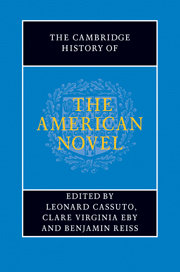Book contents
- Frontmatter
- General Introduction
- PART ONE INVENTING THE AMERICAN NOVEL
- PART TWO REALISM, PROTEST, ACCOMMODATION
- Introduction: realism, protest, accommodation
- 17 Realism and radicalism: the school of Howells
- 18 James, pragmatism, and the realist ideal
- 19 Theories of the American novel in the age of realism
- 20 The novel in postbellum print culture
- 21 Twain, class, and the Gilded Age
- 22 Dreiser and the city
- 23 Novels of civic protest
- 24 Novels of American business, industry, and consumerism
- 25 New Americans and the immigrant novel
- 26 Cather and the regional imagination
- 27 Wharton, marriage, and the New Woman
- 28 The postbellum race novel
- 29 The African American novel after Reconstruction
- 30 The rise of naturalism
- 31 Imagining the frontier
- 32 Imperialism, Orientalism, and empire
- 33 The hemispheric novel in the post-revolutionary era
- 34 The woman's novel beyond sentimentalism
- 35 Dime novels and the rise of mass-market genres
- 36 Readers and reading groups
- PART THREE MODERNISM AND BEYOND
- PART FOUR CONTEMPORARY FORMATIONS
- A selected bibliography
- Index
27 - Wharton, marriage, and the New Woman
from PART TWO - REALISM, PROTEST, ACCOMMODATION
Published online by Cambridge University Press: 28 July 2011
- Frontmatter
- General Introduction
- PART ONE INVENTING THE AMERICAN NOVEL
- PART TWO REALISM, PROTEST, ACCOMMODATION
- Introduction: realism, protest, accommodation
- 17 Realism and radicalism: the school of Howells
- 18 James, pragmatism, and the realist ideal
- 19 Theories of the American novel in the age of realism
- 20 The novel in postbellum print culture
- 21 Twain, class, and the Gilded Age
- 22 Dreiser and the city
- 23 Novels of civic protest
- 24 Novels of American business, industry, and consumerism
- 25 New Americans and the immigrant novel
- 26 Cather and the regional imagination
- 27 Wharton, marriage, and the New Woman
- 28 The postbellum race novel
- 29 The African American novel after Reconstruction
- 30 The rise of naturalism
- 31 Imagining the frontier
- 32 Imperialism, Orientalism, and empire
- 33 The hemispheric novel in the post-revolutionary era
- 34 The woman's novel beyond sentimentalism
- 35 Dime novels and the rise of mass-market genres
- 36 Readers and reading groups
- PART THREE MODERNISM AND BEYOND
- PART FOUR CONTEMPORARY FORMATIONS
- A selected bibliography
- Index
Summary
“When a girl leaves her home at eighteen,” writes Theodore Dreiser at the outset of Sister Carrie (1900), “she does one of two things. Either she falls into saving hands and becomes better, or she rapidly assumes the cosmopolitan standard of virtue and becomes worse.” We see encapsulated here the two dominant plots for women over the first century of the American novel. In the one case, a laborious program of self-improvement, culminating in marriage; in the other, a swift fall into seduction, terminating in death.
Both of these denouements, scholars have suggested, may be read in broader historical terms, as attempts to manage the crises of modern individualism via the marriage plot. When a young woman seeks to chart the course of her own life, guided by her own desires rather than inherited norms, what results? For its proponents, modernity's freedoms – as represented by the founding of liberal democracies like the USA – offered unprecedented opportunities for the progressive betterment of all human beings, loosed atlast from the dead weight of tradition. Detractors feared the opposite, a universe evacuated of meaning or purpose, with human activity reduced to an unending, chaotic struggle among atomized, pleasure-seeking selves. In the wake of the French Revolution, this dystopic vision loomed largest. Thus, in the 1790s, heroines like Eliza Wharton of The Coquette (1797) appear dangerously “volatile” (ever-changing, unstable) in their insistent “pursuit of happiness“; by killing them off, the novel imposes moral closure on a journey of desirous self-exploration that otherwise threatens to defy all limits.
- Type
- Chapter
- Information
- The Cambridge History of the American Novel , pp. 452 - 469Publisher: Cambridge University PressPrint publication year: 2011
- 13
- Cited by



